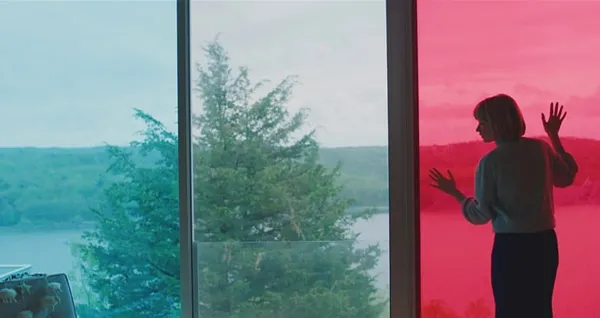 |
| Haley Bennett in Swallow |
Carlo Mirabella-Davis’ haunting psychological horror drama Swallow received great acclaim when it hit the festival circuit last year and has been winning praise from audiences ever since. He and I were scheduled to talk in March, when it first became available online, but unfortunately I came down with Covid-19 and it had to be put on hold. When we reconvened a couple of months later he, still unscathed, was curious about the illness, asking me if I’d lost my sense of smell or taste – something which I had to confess I hadn’t paid attention to, as no-one knew it was a symptom at the time. I did notice it affecting my gut early on, but thankfully it didn’t give me the strange appetites of the heroine of his film, Hunter (Haley Bennett), who experiences a compulsion to eat strange objects, probably as a response to stress. I suggest to Carlo that this was a bold subject to take on in his first feature.
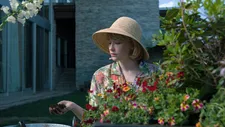 |
| Getting out of the house |
“I did a short that was at Sundance a few years back and I co-directed a feature documentary, called The Swell Season,” he says, “but yeah, this is my first fiction feature, written and directed by.
“So the film was inspired by my grandmother, who was a homemaker in the 1950s, in an unhappy marriage, who developed various rituals of control. She was an obsessive hand washer and she would go through four bars of soap a day and 12 bottles of rubbing alcohol a week. I think she was looking for order in a life she felt increasingly powerless in. My grandfather, at the advice of the doctors, put her into a mental institution where she was given electroshock therapy, insulin shock therapy and a non-consensual lobotomy, and she lost her sense of taste and smell.
“I always felt that there was something punitive about it, that she was being punished in a way for not living up to society’s expectations of what they felt a wife and a mother should be, and being different. So I always wanted to make that film about that, but handwashing is not very cinematic, you know? Or maybe it’s becoming more cinematic now that we’re all doing it.
“So I remember seeing a photograph online of all the contents of someone’s stomach who had pica – all these objects that had been surgically removed and fanned out on a table, like an archaeological dig. I was fascinated. I wanted to know what drew the patient to those artefacts. It almost felt like something mystical, like a holy communion. I wanted to know more and that’s how it began.”
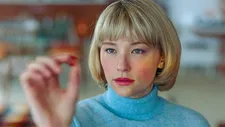 |
| The marble |
How did he approach making the objects that Hunter craves look so delicious, even when it was obviously a bad idea to eat them?
“I was very fortunate to work with an amazing design department and Katelin Arizmendi, our amazing cinematographer is a true visual genius and really understood how to use lighting and these master prime lenses in order to capture all of the subtle prismatic beauty of the marble, and our amazing production designer, Erin Magill, has an incredible imagination and eye for colour. She was very focused on choosing the exact right objects and we had lots of conversations about ‘Oh, is it that marble, or this marble, or that one?’
“Ultimately, in terms of the writing of it, I wanted each object to represent a kind of emotional memory, to have its own emotional flavour. So the marble, you hear on the sound design the distant sounds of the sea, birds overhead, seagulls, people laughing, and it’s supposed to represent some childhood memory of happiness that feels lost, whereas the thumbtack is sort of whispering to her like a siren, a dangerous liaison or something.
“Each of the moments with the objects has a triggering scene that happens before it and shows us why she goes towards the compulsion for comfort. But on set we used all kinds of little tricks with the lighting and with the lenses with the objects themselves to make them seem alive and appetising.”
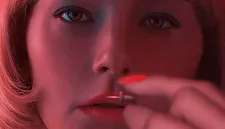 |
| The thumbtack |
The set itself is fascinating, decorated like a show home in delicate pastels, drained of personality so that one might project anything into that space.
“I love that interpretation,” he says. “Yeah... I remember looking around for the house, and ever since I saw The Shining I’ve been committed to the idea that location is a character in itself. When we walked onto that set I looked around and I thought ‘My God, this is like a Hitchcock film!’ You know, with the view and the colours – and there were even these huge rotund sculptures on the outside of the house that look like marbles, so it felt like destiny. And one of the things I realised is that when you’re in that kind of ultra-modern glass house – they also have one in Parasite – you think you’re going to be holistically integrated into nature but you wind up feeling quite vulnerable, like you’re inside a glass display case, especially at night when the house lights up like a lantern and you feel the eyes of the woods on you.
“I thought it was a good metaphor for Hunter, that she’s trapped in this invisible prison, this display case, representing the restrictions of expectation that this wealthy patriarchal family has on her. But everything in the house is designed by Erin Magill and she was very passionate about the idea that every single component of the house is a storytelling opportunity because Hunter is decorating the home the way she thinks the family wants it to be, but at the same time Erin and I worked out these little moments where we see Hunter’s true self emerge stylistically, like when she puts the red gels over the baby’s room window and suddenly that colour pop – a little Suspiria reference – makes you feel that she has reservations about this role, or that it’s her power and true emotion emerging. And Erin had this great idea that all the furniture should look like objects that Hunter might want to consume of it were smaller, so all of the little ornaments and the coffee table, they all resemble that.”
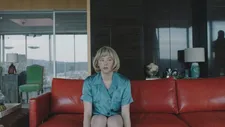 |
| The furniture |
The way that Hunter herself is shot is also fascinating. She starts off looking like a piece of furniture, barely moving, and then towards the end, when the film shifts gears, she’s very active – clearly a person.
“Kate Arizmendi and I came up with a very rigid vernacular for our camera direction, a strict set of rules that we would then break at key emotional junctures,” he explains. “At the beginning, Kate keeps Hunter in a lot of master shots that are very formal and locked down, where Hunter’s sort of lost in the frame or dominated by the space, and then Kate would suddenly use a shallow depth of field close up, or handheld, to show those psychological hinge moments. That, I think, reflects the change you’re talking about. Also, Hunter begins to realise the family sees her as kind of an ornamentation to Richie’s life – kind of like the ornaments that she consumes – and as a vessel for their legacy. She’s like part of the house and then she starts to break away from it. Even though the compulsion is dangerous, it serves as a kind of catalyst for her to discover her true self and revel from this oppressive space she finds herself in.”
I find her interesting as a choice of character because she’s the sort of person whom we would more often expect to encounter as a supporting character in someone else’s story, the kind of character we don’t usually meet.
“Yes, I was very interested in that,” he says. “We even went so far as to start the movie as if it was Richie’s story. We start with him getting a celebration. He gets the first close-up, and he introduces Hunter as his wife who’s supporting him to achieve this great thing. That was to show that he sees her as a secondary character in his life, that she’s there to support his journeys. in a lot of movies she’s the sort of character that would get a few scenes and a few lines and we’d never really get to explore her world and her space. We wanted to explore her world and her journey in this film.”
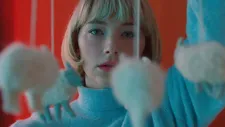 |
| Sweet dreams |
One character whom we meet only briefly is brought vividly to life by Denis O’Hare – but we agree that we can’t talk much about that for fear of spoilers.
“I’ll just say that I’ve long admired him as an incredible, truly brilliant actor. I’ve seen him in many, many films and television shows, including American Horror Story. Our wonderful casting director, Allison Twardziak, spent a lot of time in the New York theatre scene and had seen him in many productions. It seemed like it would be wonderful if we could get him. He agreed to do the role, which we were over the moon about, and his performance was incredible.”
How did they secure Haley Bennett for the lead? Ultimately, everything hinges on her performance, and she’s very impressive.
“We knew early on that the whole movie depended on casting an amazing actor as our lead, and also that we needed someone who could effortlessly bring the audience into their internal cosmology, because it was an unusual tale and we really wanted to tell a story that would bond the audience to the main character and make the audience feel what she was feeling. Allison brought up Haley and I saw Girl On A Train and I was completely floored by Haley’s incredible performance. we all agreed she was perfect for the part and I wrote her a letter and offered her the role
“ I just assumed that she would be too busy to do the film. It was a long shot, I figured, because she’s been in a lot of big movies. But amazingly she responded and we had a great meeting and there was an instant artistic bond, a real meeting of minds. We both got really excited about the possibilities of what this story could be, and wanted to tell the story together.
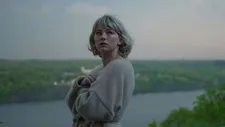 |
| On the edge |
“We were so lucky that Haley came on board and brought Hunter to life with such care and clarity and insight and focus and power. She was also an executive producer on the film, so she really was very generous with her time and poured her soul into this. It was a labour of love for her as it was for everybody on the movie.
“Haley is so good with layers of emotion and Hunter wears multiple masks throughout the film. The first mask is that reflection of normalcy, reflecting what her husband wants her to be, the placid smile. There’s that second mask which is her pain, her doubt. Is this really where I belong?? And then the third mask, her true self, her primordial self emerging. Haley can give you all f those emotional layers with just a twitch of her eye or a touch of her hair. She has such power and presence conveying Hunter’s journey throughout the course of the movie – there’s a lot of psychological movement, arcs and changes, and Haley’s really good at that sort of range – so we were really fortunate she decided to tell the story. I can’t wait for people to see her performance.”
One of my favourite scenes in the film is the final scene, where we linger in the communal area of a women’s toilet block, watching a number of women come and go. It leaves the viewer curious about their stories, wondering if they’re full of secrets like Hunter is.
“Yes, exactly,” he says. “We spent a lot of time in our script rewrites fine tuning that ending. My incredible producers Mollye Asher and Mynette Louie and I spent time thinking about the right kind of beat to end the movie on, and it’s exactly what you say. We wanted to show that we’ve spent this time with Hunter but this is a story that’s kind of universal and you could look at any of the women passing through in that final shot and think ‘Oh, maybe she’s dealing with something similar,’ or ‘What’s going on with her? What’s her story and what’s her journey?’ so it was supposed to leave audiences feeling that kind of connection and that sense of interest in the universality of the tale.”
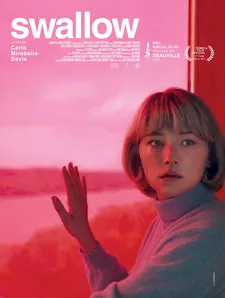 |
| Swallow poster |
How do he and his team feel about the way that the film has been received?
“We’ve been over the moon about it. It’s incredible to see the response an the outpouring of connection that people have with the movie is really moving, especially since it’s a personal story from my family. A lot of people have come up after the screenings and told me their own stories. It’s interestingly also striking a chord with the pandemic because it’s a lot about isolation and tools of control at a time when we’re all feeling kind of out of control of the situation. We released online and there’s been this incredible groundswell of fan art and people writing about the film and really people taking it into their personal cosmology which is great. We won 23 awards on the festival circuit, which is really exciting, and the critics’ response has been incredible. It’s been amazing to see all these journalists and film theorists write about the film, so we’re really happy.”
Finally, after an unexpected success like this, what’s he going to do next?
“I just want to keep making movies that will – hopefully – make people feel seen. I love films that are bold and daring and I believe movies really can change the world. They can fight prejudice, increase empathy, bring us together. And I want to make films that are a little dangerous, that put characters on the screen that maybe we haven’t seen before. I think we’re in an interesting time when genre movies or movies that have genre elements are resonating psychologically and sociologically. with amazing films from Get Out to The Babadook, you really sense that there’s an interesting movement happening, so I’m really interested in exploring that as well. I’m working on a feminist supernatural horror movie and some other projects, so I just hope I can keep making movies!”





















